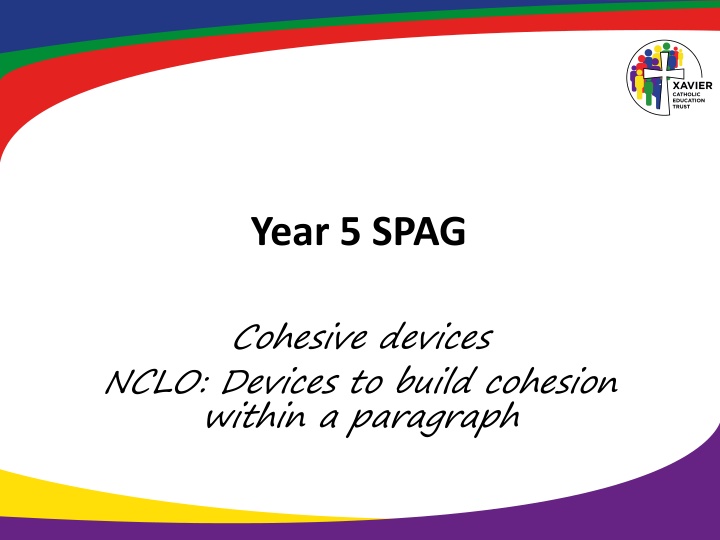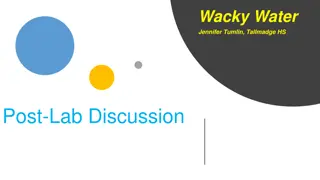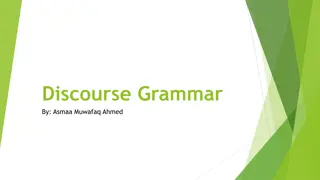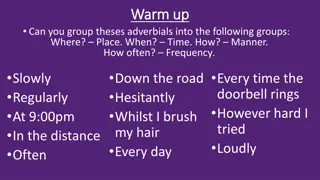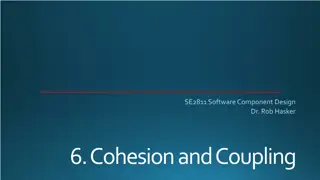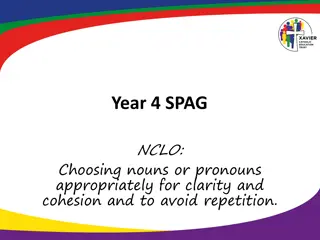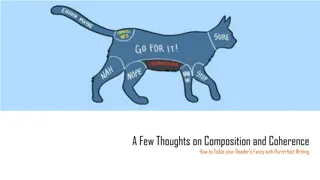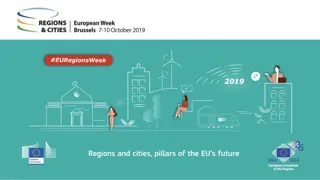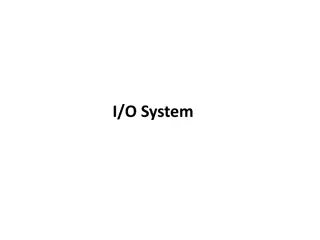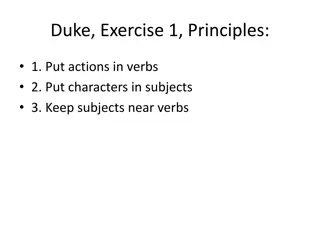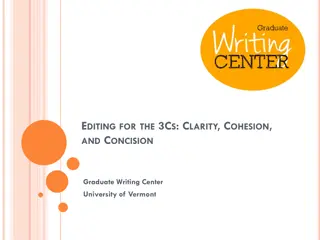Building Cohesion in Writing: Cohesive Devices and Techniques
Understand the importance of cohesion in writing and how to achieve it using cohesive devices such as conjunctions, transitional phrases, synonyms, and pronouns. Learn how to organize your ideas coherently, use signposts effectively, and structure your writing for better readability. Enhance your writing skills through clear organization, logical flow, and effective paragraphing strategies.
Download Presentation

Please find below an Image/Link to download the presentation.
The content on the website is provided AS IS for your information and personal use only. It may not be sold, licensed, or shared on other websites without obtaining consent from the author.If you encounter any issues during the download, it is possible that the publisher has removed the file from their server.
You are allowed to download the files provided on this website for personal or commercial use, subject to the condition that they are used lawfully. All files are the property of their respective owners.
The content on the website is provided AS IS for your information and personal use only. It may not be sold, licensed, or shared on other websites without obtaining consent from the author.
E N D
Presentation Transcript
Year 5 SPAG Cohesive devices NCLO: Devices to build cohesion within a paragraph
Cohesive devices What is cohesion? How can we tell if something is cohesive? How do we achieve it? What are cohesive devices? Can you think of any examples? What makes out writing cohesive?
What do I need to know? Cohesive devices are useful conjunctions, transitional phrases, synonyms and pronouns that express ideas in a cohesive manner. They are used to join sentences together to make ideas more understandable to the reader.
Text has cohesion if: it is clearly organised so readers can find their way round the ideas. it includes words and phrases that act like signposts , helping readers to follow the author s train of thought. the writing holds together , so that it is easy to read and understand.
Coherence Some ways of helping the reader see how your ideas are organised. Layout conventions show what sort of text it is, e.g. diary, letter, newspaper, article. Headings and subheadings give an overview of the text s organisation. Punctuation Paragraph breaks show shifts of time, place, viewpoint, topic, etc. shows where one chunk of meaning ends and another begins. Presentational devices draw attention to sections of text and make meaning clearer * Plan your writing in advance on a skeleton framework. * Frequently re-read your work to check organisation is clear. e.g. speech bubbles, timelines, flowcharts, etc. bullet points, boxed information.
Paragraphing Paragraph breaks can help readers to follow your train of thought by showing a shift of time a new topic or aspect of a topic Three weeks later In 1837, one paragraph per category a new step or stage in a process a shift of place Meanwhile, deep in the forest, a new speaker in direct speech (See The Sentence Book) a move from one main point (or group of points to another * * * * In non-fiction writing, plan paragraphs beforehand. * In fiction, beware of all shifts of emphasis. a shift of mood or viewpoint *** *** Suddenly, they leapt Into action Tom, on the other hand, was furious
Cohesive devices Words and phrases can act like signposts to help readers see significant links in the text. conjunctions These show links between ideas within a sentence, e.g. when, because, until, although. sentence connectives Words and phrases that show links between one sentence and the next, e.g. However, Consequently, On the other hand Connection words, phrases and sentences are important throughout written work. However, they are particularly useful at the start of a new paragraph. sentence frames Where nouns or verbs act as signposts, you can make a sentence frame , e.g. Begin by The reason that is punctuation Some punctuation marks (: ; -) can show links between clauses. Use these signposts to link your own ideas. Practise the sentences in speech before you write. Collect examples from texts you read. Read sentences aloud to get the feel of the language patterns.
Time Links Use time links to show the passage of time in fiction and recounts. e.g. Vary the linking devices so they guide the reader without being too obvious. time passing Next, Then, After that, A few weeks later, By the end of October, setting the scene conclusion sentence connectives Finally, Eventually, At last, Yesterday, On 4th June 2000, One wintry morning, conjunctions linking clauses As time went by, After she had left, When Jane was four years old, When it was all over, Several weeks passed. The clock struck midnight. It all began with an invitation. It was the end of the adventure. sentence frames
Cause and effect The room is cold because the window is open. When the window is open, the room is cold. If the window is open, the room is cold. The window is open so the room is cold. conjunctions linking clauses sentence connectives The window is open. Therefore, the room is cold. Consequently, the room is cold. As a result, the room is cold. The window is open. This means that the room is cold. This results in the room being cold. This causes the room to be cold. sentence frames The reason (that) the room is cold is that the window is open. Note that some sentence frames lead to changes in the form of the verb. Cause and effect links are particularly important in explanation writing.
+ Addition + Opposition and as well too Also, Moreover, Furthermore, In addition, What is more, Another point is A further feature is but yet while whereas However, Alternatively, On the other hand, On the contrary, The opposite point of view is These links are useful in descriptive writing texts which argue for or against a point of view. Comparison, e.g. ____________ and _______ are similar in several ways. Contrast, e.g. ____________ and _______ are different in a number of ways. For instance, __________ is _______, while __________ is ____________. One similarity is that __________. Another way in which they are alike is ________. They are both ____________. Another difference is that ________. They also differ in that _________ is ________, whereas ________is ________. A further feature they have in common is____________.
Sequence In instructions and explanations, signpost stages in the process, 3 2 4 1 Next, When the mixture is ready Secondly,.. The next stage is Finally, Finish off by First, Begin by
Clarity Definitions and examples help make meaning clear, Use key words and sentence frames to introduce them. Introducing examples e.g. such as including For example, For instance, This can be seen in This is illustrated by Examples include Introducing definitions a bloop, which is a a , known as a bloop a called a bloop a bloop (a )
Holding text together 1 Nouns, noun phrases and pronouns help bind text together by making references back and forward. Make sure pronouns are consistent in person and number. If not, the text may be confusing to read. Rob knocked on the door. An old woman opened it and stared down at the boy. He smiled back. This must be Mrs Gunn. If one wants to be a top-class player, we have to practise because players do not make it to the top unless you give a hundred per cent. Use a variety of nouns, noun phrases and pronouns to: avoid repetition improve the cohesion of your writing. In impersonal text, stick to third person pronouns. If you start in the singular, don t drift into the plural.
Holding text together 2 Some texts are mostly past tense: recount narrative fiction Reported speech is in the past tense. Some texts are mostly present tense: instruction report explanation persuasion discussion Make sure verb tenses are consistent. If not, the text may be confusing to read. Direct speech is usually present tense. The general said that his men were fit and highly trained. They would be ready when the invasion began. Exceptions * most direct speech and quotations * references to things which continue to exist beyond the narrative * sudden changes into the present tense for dramatic effect. My men are fit and highly trained. They will be ready when the invasion begins, said the general. Exceptions * historical reports and explanations * reference to or examples from the past.
Holding text together 3 Make sure your overall style and viewpoint are consistent, depending on purpose and audience. impersonal or personal I, we, you third person and/or passive voice (see The Complex Sentence Book) or formal informal or subjective objective your opinion just the facts
Task A: Find the adverbials Which adverbials link the ideas in these paragraphs? After we took off from New York there was some turbulence, but most of the journey was fine. What a week we had! First, we climbed to the top of the Empire State Building. It was magical. Similarly amazing was the Statue of Liberty, which we saw the next day. That afternoon it rained. Consequently, we went shopping! Next day, the weather improved. Furthermore, it was the day we had booked our tour of Yankee Stadium. I have always wanted to see inside the real stadium. Therefore, this was a dream come true for me. In contrast to the tour of Yankee Stadium, the next day was not exciting. Nevertheless, the Guggenheim Museum was quite interesting...! In summary, I really enjoyed my week in New York!
Task B: Sequence the paragraphs With a partner, decide the best sequence for these paragraph starters, which are from the text of an argument. The opening line of the argument is given below. These days, there is some debate about whether school children should wear a uniform. Another thing to consider is... Others say... On the one hand, I agree that... Finally, I think that... On the other hand, I believe... Consequently, in my view,... Although many people think that... When you have the paragraph starters in order, have a go at completing the argument.
https://www.dlsweb.rmit.edu.au/lsu/content/4_writingskills/writing_tuts/paraghttps://www.dlsweb.rmit.edu.au/lsu/content/4_writingskills/writing_tuts/parag raphs_ll/activity4.html https://education.nsw.gov.au/teaching-and-learning/student-assessment/smart- teaching-strategies/literacy/language-conventions/stage-3/cohesion
